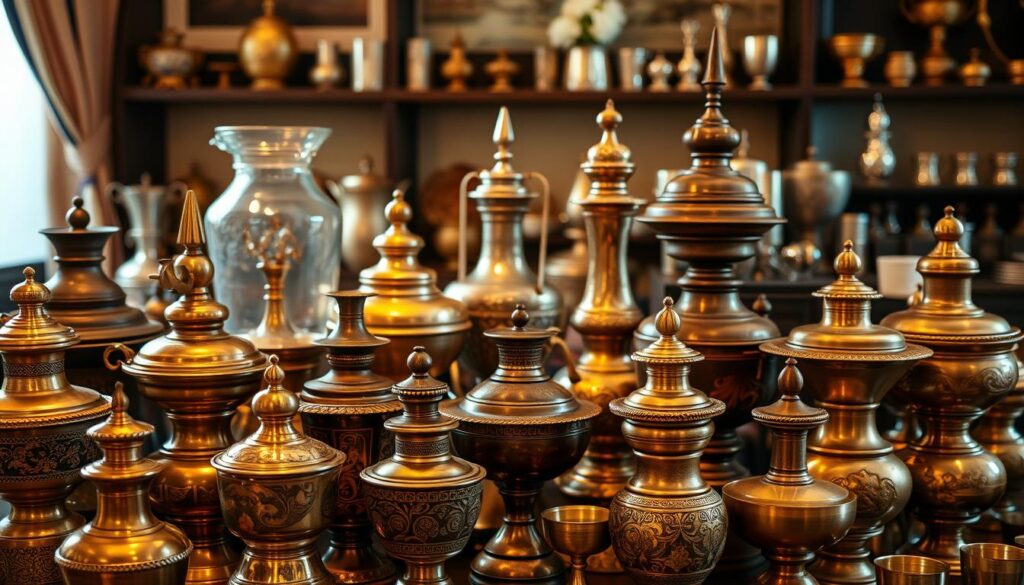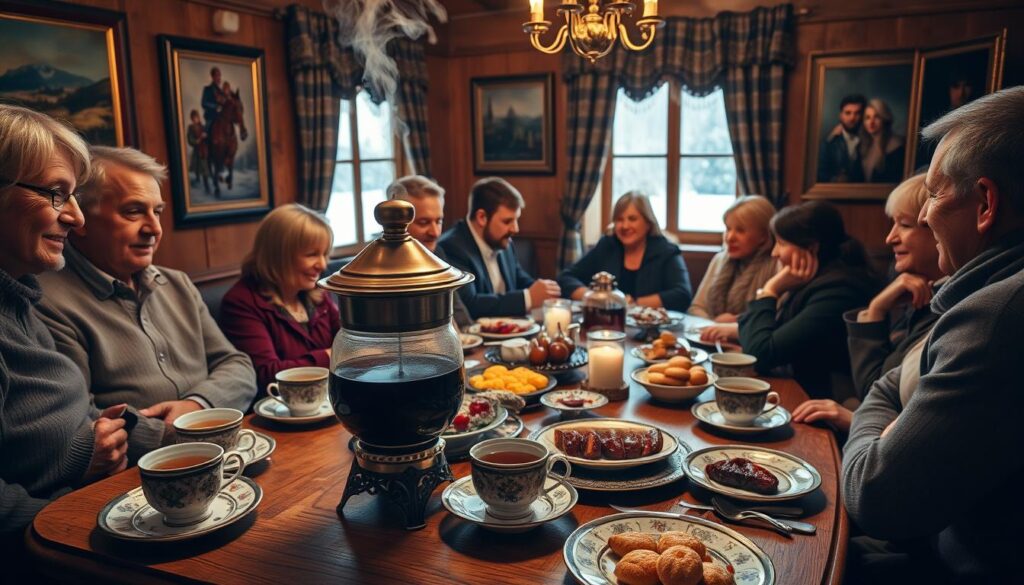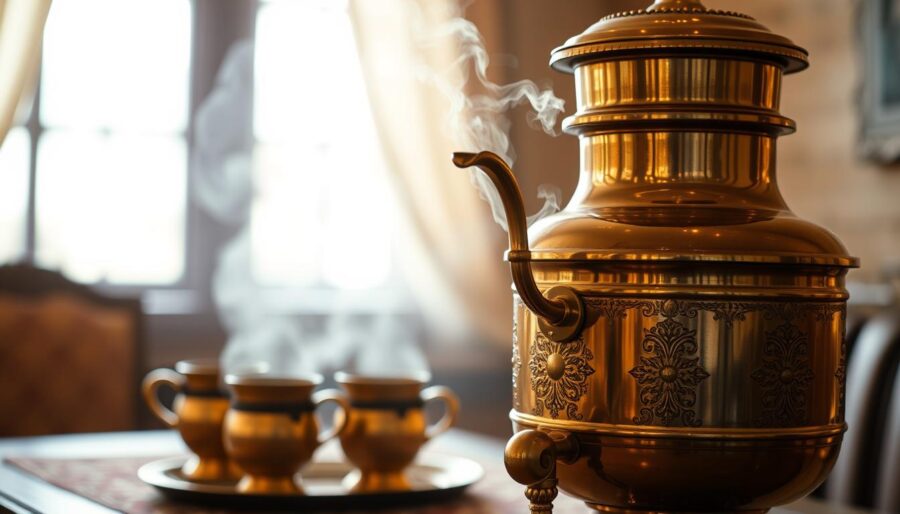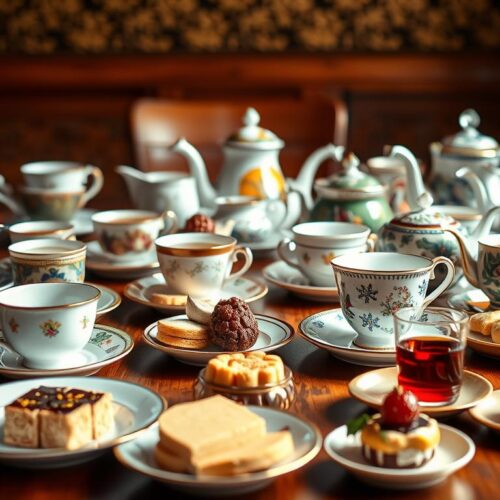The samovar is more than a tool for making tea. It symbolizes Russian tea culture and welcoming ways. Introduced to Russia in the 17th century by Cossack immigrants from Persia, it has a deep history. This iconic item has become central to social events, symbolizing the warmth and friendliness of Russian hospitality.
Exploring the tea drinking tradition with a samovar shows its role in bringing people together. It allows for ongoing tea brewing and helps create strong bonds among family and friends.
Understanding the Samovar’s Historical Significance
The samovar’s story began in the 18th century in Tula, Russia. These “self-boilers” were made to keep up with Russia’s growing love for tea. This was thanks to trade with China, which brought fine teas to Russia. The samovar became a key part of Russian life as tea drinking became popular.
By the 19th century, samovars became a symbol of Russian tea culture. They showed hospitality and brought people together. Samovars were not just practical; they also helped create special moments among loved ones.
Antique samovars are treasures of history. They display incredible craftsmanship and styles from various times. Each samovar tells a story about its creator and the society it came from. Learning about samovars opens a window into Russian identity and traditions.
The Cultural Importance of Tea in Russia
Russian tea culture is more than just drinking tea. It’s a tradition rich in rituals and social bonds. Tea is key in Russian hospitality. Offering tea to guests means a lot in terms of friendship and unity.
At the heart of this ritual is zavarka, a strong tea concentrate. It lets people adjust their tea how they like. By adding hot water to their taste, everyone can enjoy their tea in a unique way. This makes tea time a personal yet shared experience.
Russian tea times are long and relaxed, unlike the quick coffee breaks in the West. They show how Russians value relationships and open talks with loved ones. Joining in this ritual means embracing a culture of togetherness and kindness.
Types of Samovars
Samovars are special tea pots, each made to offer a special tea-making and serving experience. Knowing the different kinds of samovars can make you appreciate the Russian tea tradition more. This includes the accessories needed for these traditional tea pots.
Traditional samovars use fire and have a chimney pipe look. They work with charcoal or wood to keep the tea hot. This lets you have fresh tea anytime. These old-style samovars are also very pretty, often becoming the main attraction of tea gatherings.
Modern electric samovars, like the SAKI Electric Russian Samovar, mix old traditions with new tech. They keep the tea hot without needing you to watch over them. With a simple button push, you can have your tea ready. This means less trouble with charcoal or wood and more time enjoying your tea.
Antique samovars, sought after by collectors, are made from metals like copper or brass. Each one is both useful and a beautiful art piece. They show the skill of their makers. Knowing about these samovars helps you pick the best one for your taste and needs.
Below is a comparison of the different types of samovars:
| Type of Samovar | Heating Method | Features |
|---|---|---|
| Traditional Samovar | Charcoal/Wood | Unique chimney design, continuous heating capability |
| Electric Samovar | Electric | Convenience, easy temperature control, no maintenance of fuel |
| Antique Samovar | Varies (often Traditional) | Artistic craftsmanship, unique designs, collector’s items |

How to Use a Samovar at Home
Using a samovar at home brings friends and family together for tea. First, fill your samovar with fresh, cold water. Then, heat it up till it starts boiling. In a separate teapot, prepare a strong tea mix called zavarka. This will make your tea taste better.
As soon as the water starts to steam, pour it on the tea leaves to start brewing. In a few minutes, the tea will have a strong flavor. You can then serve the tea, letting guests add sugar, lemon, or jam as they like. This way, making tea with a samovar turns into a fun social event.
| Step | Action |
|---|---|
| 1 | Fill the samovar with fresh cold water. |
| 2 | Heat the water until boiling. |
| 3 | Prepare a strong tea concentrate (zavarka) in a teapot. |
| 4 | Pour boiling water over the tea leaves to brew. |
| 5 | Serve the tea in cups and allow guests to add flavors. |
Samovar Maintenance and Care
Keeping your samovar in good shape is key to its long life. To do this, you need to follow some important steps. Make sure to clean both inside and outside after you use it. This removes tea leftovers and limescale that can harm its look and work.
For those with traditional samovars, always check the chimney and spout to avoid clogs. Blockages can stop your samovar from working well. For electric samovars, watch out for water build-up. And don’t forget to check the heating parts for any damage to prevent sudden fixes.
Maintaining your samovar not only keeps it looking great but also working properly. By taking a little time for upkeep, your samovar will stay a beloved item in your home for many years.
Hosting a Traditional Russian Tea Party
A traditional Russian tea party is a great way to explore and share Russian tea traditions. Start with a variety of authentic teas. Options include classic black teas like Russian Caravan and calming herbal teas.
When setting up your tea party, add traditional Russian snacks to your table. Baranki, pryaniki, and various fruit preserves offer a taste of Russia. This adds rich flavors and lets guests customize their tea with sweeteners and lemon. It makes the tea party more personal and connects everyone.
The heart of a Russian tea party is in making everyone feel welcome. Create a space for slow conversations that show the warmth and hospitality of the Russian samovar tradition. Your tea party will please your guests’ tastes and help build strong friendships through shared stories and laughter.

The Role of Samovars in Celebrating Events
Samovars are more than tools for making tea in events; they carry the heart of Russian traditions. These beautiful items often become the focus during key celebrations, religious holidays, and community parties. A samovar at an event means unity and warmth, welcoming everyone to join in.
At special gatherings, tables are filled with pastries and different teas next to the samovar. This setup highlights the importance of eating together, where sharing tales and laughter over tea tightens friendships. The spread often includes crisp cookies, traditional sweets, and appetizers, showing the depth of Russian hospitality.
Gathering around a samovar is a valued tradition, building bonds with family and culture. At significant events like weddings or New Year’s parties, the samovar symbolizes closeness and celebration. It embodies the soul of Russian gatherings during these special moments.
Iconic Samovar Brands You Should Know
The world of samovar manufacturers is filled with several notable brands. Tula is one famous brand, coming from a city known for making samovars. These Tula samovars show off traditional designs that celebrate the rich Russian tea culture.
Moscow is another important name. It offers samovars that are both classic and modern. For collectors and tea lovers, Moscow samovars are appealing because of their unique look and use. Kolomna also stands out. It is praised for making beautiful samovars that are both artistic and useful.
Looking into these iconic brands, you’ll find each has its own style and charm. The history behind these famous samovar brands adds to their allure. Getting a samovar from these respected makers gives you more than a tool. It offers a peek into the craft and tradition of the Russian tea ceremony.
The Global Influence of Samovars
The samovar is a key symbol of Russian tea culture. It has spread its influence worldwide. As travelers discover new places, they see the samovar in local traditions. This is true in places like Ukraine and Kazakhstan, where tea is also cherished.
The samovar’s global journey shows its flexibility and charm. Cafes and restaurants around the world use samovars to offer unique tea experiences. The cozy feel of a samovar invites people to chat and enjoy tea together.
The samovar makes international tea customs more interesting. It adds a special touch to both formal and casual gatherings. Tea enthusiasts everywhere value this unique feature.
| Region | Influence of Samovars | Local Tea Traditions |
|---|---|---|
| Russia | Central to tea culture, often used for family gatherings. | Traditional black tea served with various pastries and sweets. |
| Ukraine | Incorporated into celebrations and domestic life, symbolizing hospitality. | Herbal teas with honey and traditional breads. |
| Kazakhstan | Used to serve tea in a community-oriented setting. | Green tea accompanied by milk and a variety of dishes. |
| Western Cafes | Introduced as a trendy alternative for serving hot beverages. | Assorted specialty teas and pastries. |
Exploring these different uses broadens our understanding of the samovar’s role. It continues to shape tea culture around the world.
Exploring Modern Innovations in Samovar Design
Today’s samovar designs mix old craftsmanship with new ideas. Electric samovars are now popular, thanks to their latest features. They let you control the temperature perfectly, so your tea, whether green or black, tastes just right.
Samovar makers are now trying different styles. They’re making samovars that look good and work well. Many have sleek shapes and bright colors. This attracts younger people who like modern style but also value tradition.
By adding modern tech to traditional designs, samovars have become more appealing. They honor their roots while fitting into today’s homes. This mix pleases all kinds of tea lovers.
Where to Purchase or Experience Samovars
To get the full samovar experience, visiting traditional tea houses is essential. These places offer various authentic Russian teas in a warm setting. They make your time there special with a samovar tea ceremony and traditional snacks.
Looking to buy a samovar? You have some choices. Antique shops have unique, historical models while modern stores sell new ones with classic looks and updated features. You can also find a wide selection online, perfect for any taste or need.
Whether you’re sipping tea at a local tea house or bringing a samovar into your home, you embrace Russian hospitality. Brewing and sharing tea connects you to Russia’s deep traditions. It’s a way to bring warmth and rich culture into your life.




